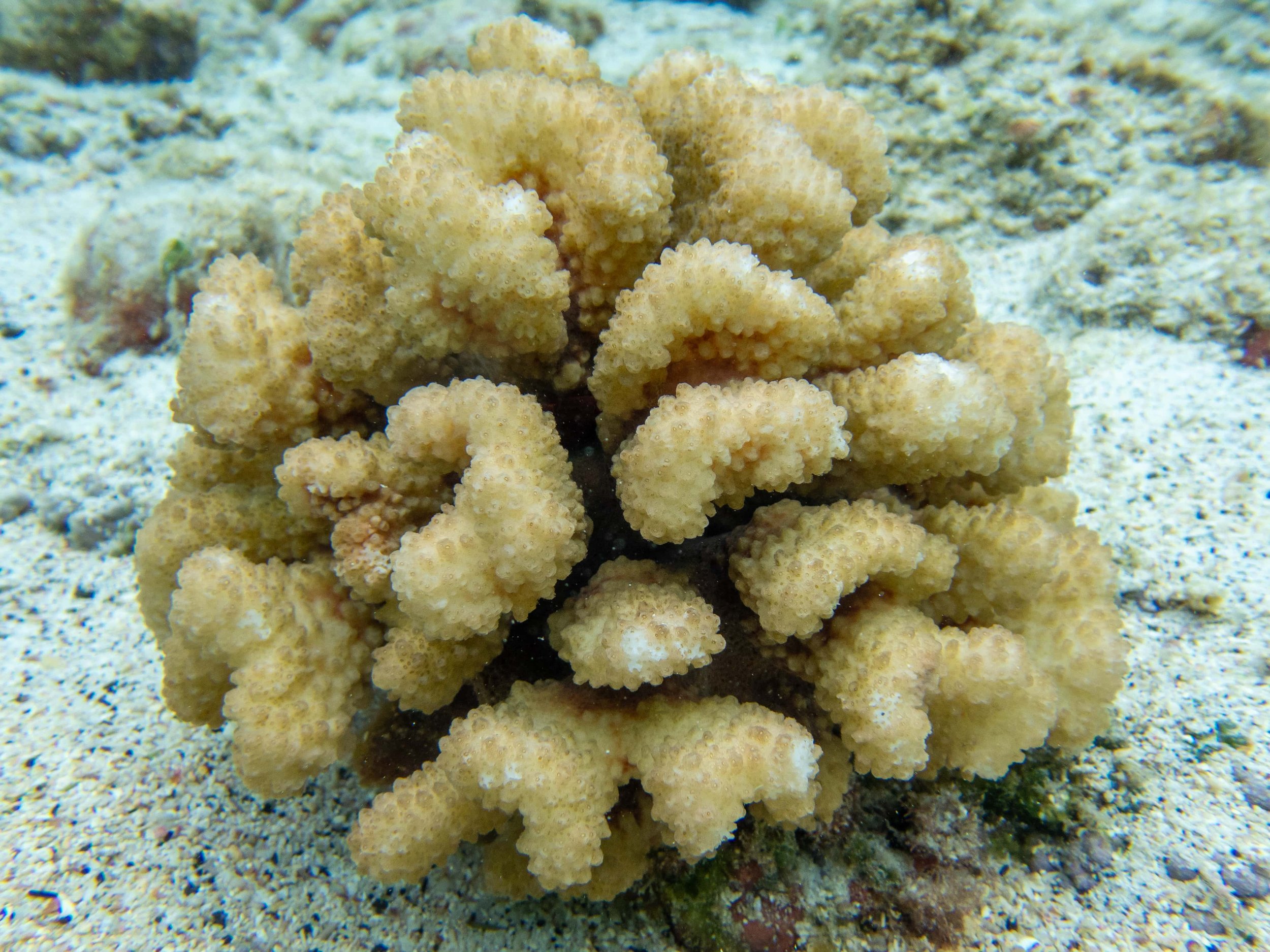Pocillopora meandrina
CAULIFLOWER CORAL
What is Cauliflower Coral?
Cauliflower coral, scientifically known as Pocillopora meandrina, is a prominent species found in coral reef ecosystems. It is easily recognizable by its unique and intricate branching structure, which resembles the form of a cauliflower. This coral species is not only a key player in maintaining reef biodiversity, but also a vital part of the marine environment due to its ecological contributions. Here’s a closer look at what makes this coral unique:
Description and Characteristics
Appearance: Cauliflower coral has a distinctive appearance characterized by its tree-like branches. The branches are typically thick and irregular, forming dense clusters that provide a textured look similar to that of a cauliflower head. The coral's coloration can range from shades of brown and pink to green, often displaying a vibrant and appealing visual presence in the reef.
Size: Cauliflower coral colonies can attain a maximum diameter of about 18 inches, but 12 inches is more common. They often occur in groups, providing substantial habitat for various marine organisms where they are plentiful.
Photo Credit: Christine Zalewski
Young cauliflower coral colony in the shallow waters of Kahaluʻu Bay.
May, 2022
Habitat and Distribution
Geographic Range: Pocillopora meandrina is commonly found in the tropical and subtropical regions of the Pacific and Indian Oceans.
Preferred Environment: This species thrives in shallow waters with good light penetration, typically at depths ranging from 1 to 20 meters. It is often found in lagoons, reef flats, and outer reef slopes. In Hawaiʻi, cauliflower coral is has historically been a prevalent species, contributing to the rich and diverse marine landscape.
Mature cauliflower coral colony nestled among yellow lobe corals taken in Kahaluʻu Bay on the Kona Coast of Hawaiʻi Island in June, 2012. Note the young cauliflower coral on the lower left. Contributed to the Dear Ocean Digital Coral Ark project by Richard Hart.
Ecological Role
Habitat Provider: Cauliflower coral plays a crucial ecological role within reef ecosystems. The complex structure of cauliflower coral offers shelter and breeding grounds for a multitude of marine species, including fish (like one of our favorites— the endemic Hawaiian domino damselfish), invertebrates, and other ocean life. This habitat complexity helps to support high levels of biodiversity, making reefs with cauliflower coral particularly active and thriving.
Reef Building: Through the process of calcium carbonate deposition, cauliflower coral contributes to the growth and maintenance of the reef structure, enhancing its resilience and stability.
Closeup images of branching coral skeleton pieces washed up on the beach along the Kona Coast on Hawaiʻi Island. Photographs by Christine Zalewski for Dear Ocean.
Fun Facts About Cauliflower Coral
These interesting facts about this unique coral species are adapted from John Hoover’s Hawaiʻi's Sea Creatures: A Guide to Hawaiʻi's Marine Invertebrates., (2019) [see reference below].
Unique Habitats: Cauliflower coral often thrives in high-energy environments where few other Hawaiian corals can live.
Wide Range: It occurs from splash pools above the high tide line to depths of over 200 feet.
Pioneering Colonizer: This coral is often the first to colonize new submarine lava flows.
Distinctive Shape: The branches are usually equal in length and may curve into a "C" shape at the tips.
Meandering Channels: Viewed from above, the branches form meandering channels, giving the species its name.
Diverse Inhabitants: Coral guard crabs, shrimps, and various fish species commonly inhabit the spaces between the branches.
Color Variations: Typically brown, cauliflower coral can also appear green or rose-pink in shallow water, with pigments that may help protect it from ultraviolet radiation.
Synchronized Spawning: Spawning occurs within a few hours after sunrise, usually 1-3 days after the full moons in April and May. Spawning events can significantly reduce water visibility to just a few feet in areas with plentiful colonies.
Size and Distribution: Colonies grow about 12 inches across and are found throughout the Indo-Pacific region.
Cauliflower coral colony photographed in Hanauma Bay in 2012.
Contributed to the Dear Ocean Digital Coral Ark project by John Hoover.
Understanding and appreciating the unique characteristics and ecological significance of cauliflower coral can inspire greater efforts to protect and preserve vital marine ecosystems. P. meandrina contributes to the overall health of coral reefs by participating in the process of calcium carbonate deposition, which helps to build and maintain the reef structure. The presence of cauliflower coral also enhances the reef's resilience to environmental stressors by promoting genetic diversity through its sexual reproduction. By supporting conservation initiatives and promoting sustainable practices, we can all help ensure the health and resilience of coral reefs for future generations.
REFERENCES AND ADDITIONAL READINGS
Hoover, J. P. (2019). Hawai'i's Sea Creatures: A Guide to Hawaii's Marine Invertebrates. Revised Edition. Mutual Publishing.
Hoover, J. P. (2001). Hanauma Bay: A Marine Life Guide to Hawaii’s Most Popular Nature Preserve. Mutual Publishing.
Eyes of the Reef: https://eorhawaii.org/photo-galleries/learn-your-corals-gallery/
https://www.marinelifephotography.com/corals/cauliflower/pocilloporidae.htm
We welcome observations you would like to share or corrections you might note. Contact us!
Photo credits: Christine Zalewski for Dear Ocean and Contributions to the Digital Coral Ark by John Hoover and Richard Hart.









